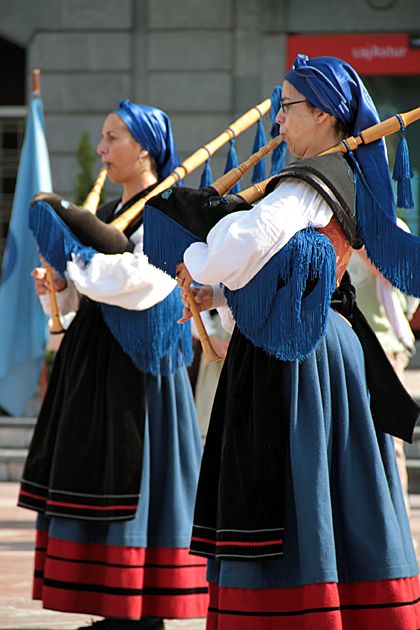
“You get to discover your instrument all over again. “The secret is to be born again every day,” Nuñez said of his ability to keep the traditional music fresh by current musical standards. While Irish-Celtic music has earned a worldwide following, the Celtic music of Galicia is finding a mainstream connection in part thanks to Nuñez’s collaboration with The Chieftains in 1996 on a ground-breaking recording, “Santiago.” The commonality of the musical styles has been the theme of much of Nuñez work ever since. Legend has it that Ireland was settled by Galicians - called “Gallegos” in Spain - who spotted the green island from a tower on Spain’s northwest point and sailed there. “Celtic is actually a whole style that has come together from many places, merging as long ago as before the Baroque period.” “Traditionally, Celtic means Irish and Scottish, but it is very much deeper than that,” said Nuñez, 42, whose Galician pipes are called the gaita gallega.

Yet, as Nuñez learnedly described during a phone interview from the tour’s first stop in Miami, the bagpipes’ historical record appears not in Ireland or Scotland but in Galicia, the area of Spain above Portugal, about 300 years before the islands to the north.

One of the world’s best-known grandmasters of the bagpipes, an energetic Spaniard named Carlos Nuñez, is bringing his latest American tour of crossover Celtic tunes for an inaugural stop in Denver a decade after passing through as a guest of Ireland’s famed traditional music group, the Chieftains.įocused on the musical interrelationships of the Celtic cultures - Nuñez comes from the northwest part of Spain whose Celtic origins predate those of Ireland and Scotland by centuries - the tour is a kick-off for his newest recording, “Inter-Celtic,” a thematic trounce through the regions most associated with bagpipe music. The bagpipes are among the world’s best-known musical instruments, largely identified with the Celtic cultures of western Europe but whose roots, scholars are finding, are actually more Iberian. To learn more about the Indigenous presence in your community please visit native-land.ca.Digital Replica Edition Home Page Close Menu As a social impact organization, our board, staff, and artists have a responsibility to consider what it means to acknowledge the history and legacy of colonialism in our history as a nation, community, and organization. Territory or land acknowledgement is our way of recognizing the Indigenous presence in our everyday life. Silkroad acknowledges that Boston, MA, is the traditional territory of the Mashpee Wampanoag, Aquinnah Wampanoag, Nipmuc, and Massachusett tribal nations. At Silkroad, we acknowledge this legacy and find inspiration from this land. We also acknowledge the painful history of genocide and forced removal from this territory, and we honor and respect the many diverse Indigenous people still connected to this land on which we gather. in Cultural Studies at Universidade de Santiago de Compostela.Ĭristina divides her time between New York City and Galicia and is married to photographer Xan Padrón. Cristina is the founder of the multidisciplinary Galician Connection Festival, writes a weekly column for the Spanish newspaper La Voz de Galicia, and was the 2019-20 Chair of Spanish Culture and Civilization at the King Juan Carlos I Center at New York University.Ĭristina holds a Doctorate of Musical Arts from Rutgers University, degrees in piano, music theory, and chamber music from the Conservatorio de Musica del Liceu, and a Master of Digital Arts from the Universitat Pompeu Fabra, and is currently pursuing a Ph.D. She has also served as Learning Advisor for Silkroad, the organization founded by Yo-Yo Ma.

In addition to her work as a performing and recording musician, Cristina has been artist-in-residence at universities including Harvard and the University of California, Santa Barbara, where she co-created a groundbreaking class on memory with neuroscientist Kenneth S.
SPANISH BAGPIPE PLAYER PROFESSIONAL
Hailed as “a virtuosic burst of energy” by The New York Times, her professional life is devoted to teaching and performance that explores the role of the arts and sciences in society. Cristina Pato is a Galician bagpiper ( gaita), a classical pianist, a writer, and a passionate educator.


 0 kommentar(er)
0 kommentar(er)
